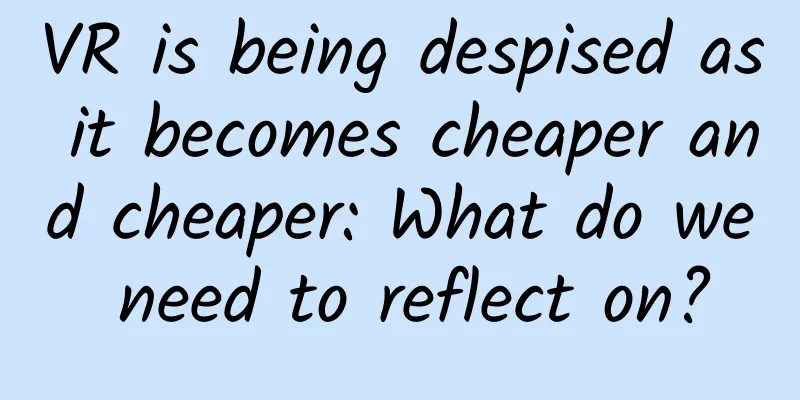VR is being despised as it becomes cheaper and cheaper: What do we need to reflect on?

|
2016 was the first year of the VR industry. International giants such as Google, Sony, HTC, Microsoft, and Facebook, as well as many domestic hardware manufacturers, Internet giants, and entrepreneurs, entered the VR field one after another. The domestic VR industry grew wildly like weeds. Today, the current development status of the VR industry is already quite worrying. According to a report on the virtual reality market in 2016 jointly released by SuperData and Unity, the total market output value of VR in the first year was 1.8 billion US dollars, and the total sales volume was 6.3 million units. In terms of total sales, the global sales volume of 6.3 million units is not optimistic. We even see that Oculus, HTC Vive and PS VR dare not disclose their sales volume publicly. IDC estimates that the sales volume of high-end head-mounted devices such as Sony PS VR, Oculus Rift and HTC Vive was 2.2 million units last year, with sales of about 1.4 billion US dollars, which is lower than IDC's previous expectations. IDC lowered its sales forecast for high-end VR devices in 2017 to 6.4 million units, with sales of 3.2 billion US dollars. Even SuperData described the sales of VR products during the Thanksgiving shopping carnival as the "biggest loser", and reduced the expected sales volume of the more popular Sony PS VR from 2.6 million to 750,000 units. However, IDC predicts that after experiencing great ups and downs in 2016, China's VR market will see a 441.2% growth in 2017. However, the situation of the domestic VR industry may not be as optimistic as IDC expected. Although VR has become a hot concept in the venture capital circle since 2016, the VR industry has experienced ups and downs in just one year, and has ushered in various cold winters in the second half of the year. At present, the enthusiasm of capital for VR is gradually cooling down. Many VR projects may be gradually abandoned by entrepreneurs and investors this year, especially since the industry is more optimistic about the prospects of AR. After Apple is about to launch AR glasses, the prospects of VR may be even worse. Comparing the domestic market with the global market, GFK found through online market monitoring data that the average monthly sales of VR hardware in China's retail market reached 382,000 units in 2016, but most of them were glasses cases, with almost no high-end brands. The average price of a unit was 137 yuan, and the unit price continued to decline, and both price and sales seemed bleak. At present, the domestic VR industry has gradually become a despised industry. At the end of last year, CCTV criticized virtual VR for changing its taste, and VR boxes entered the cottage mode ahead of time. However, this cottage mode is still continuing to advance. Recently, there was news that many sellers in Huaqiangbei used "factory direct sales" and "wholesale low prices" as sales labels, directly lowering the black technology level and quality of VR. Recently, in China, an employee of a VR manufacturer claimed that his company's VR box is 10 yuan each, has no technical content, and is getting cheaper and cheaper, which is garbage. Many consumers who have experienced VR in experience stores almost ask in surprise: "Is this VR?" As an industry representing cutting-edge technology, why does it make people feel disdain and contempt when they mention VR? What does the entire industry, especially the domestic VR industry, need to reflect on? The author believes that the industry needs to reflect on the root of this contempt. First, a typical feature of the development of the domestic VR industry is that it has adopted a cheap and cost-effective sales route through the large-scale mass production of shoddy and inferior products, which has led to the premature release of its industry dividends and the stagnation of brand potential. When Chinese people mention VR, they often think of low-quality and low-priced VR glasses and VR boxes that cost 300 to 400 yuan. A large number of low-quality VR headsets have flooded the market, causing consumers to lose their sense of fashion, black technology, and the future of VR. Secondly, the market is booming, but the technology is immature. Without thinking clearly about what to do, they all chose the easiest and lowest threshold. Many manufacturers with Internet backgrounds have also continued to enter the VR industry through the model of PPT + press conference. Manufacturers of all sizes are flocking to VR boxes that require the least technical threshold and are low-cost. For a time, all the hardware manufacturers that originally made mobile phones, mobile power supplies, and routers came. Current data shows that more than 90% of consumers in the domestic market buy VR boxes that cost less than 100 yuan. In addition, there is a lack of research and development funds, and the market is frantically following the trend to make quick money, resulting in the current VR being basically defective products, with the lowest cost price being only around 10 yuan. The bottom-line-less dumping of many manufacturers has caused the brand stereotype of VR products to continue to decline, and has also made consumers and capital lose confidence and patience. Thirdly, we need to reflect on how to maintain the VR experience store model. Currently, VR experience stores at home and abroad have basically failed. The "White Paper on the Current Status of VR Experience Stores in China" shows that among the 3,000 VR experience stores surveyed nationwide, only 26% achieved profitability in 2016, and the vast majority of experience stores are still in a loss-making state. Many VR experience stores have closed down or are in a stalemate. In early February this year, Facebook was reported to have closed 200 offline Oculus Rift experience stores, almost cutting 40% of the 500 experience stores opened in the United States. As for the form of VR experience stores, the industry needs to reflect on how to balance the offline venue rental and profit model, and how to break the mediocrity of the content of its VR experience stores. The poor quality of VR images in the experience stores, easy delays and freezes, and the failure to update in time have also seriously affected the user's repurchase rate. If the experience store brings people a consumption experience that is just like a high-end game hall or movie hall, then for this type of game, it is difficult for ordinary consumers to have a long-term addiction. Currently, many users do not have enough understanding of the VR industry, which leads to cognitive misunderstandings. They think that VR is mainly about wearing a helmet to experience various virtual reality games. However, even the current VR game experience has not solved the real problems of dizziness, rough hardware and insufficient game content. Here, the industry also needs to reflect on why the bottleneck of diversified content development in the VR industry has not been resolved. This is a key factor in the future explosion and popularization of the VR industry. For example, many game content developers are currently unable to make money from games and have begun to re-examine their VR strategies. For example, when RocketWerkz, a well-known international game developer, released one of the first virtual reality (VR) games last year, it invested about $650,000 in development costs, and has only recovered about 60% so far. Now, RocketWerkz has returned to developing traditional PC games. The puzzle game "Light Repair Team #4" has become a recommended game by many international VR manufacturers, and many users have given it good reviews, but its developers still do not make money. Of course, this type of VR game developer is just the tip of the iceberg of the entire group of unprofitable VR content developers. Here, for the entire VR industry, how to promote the integration of software, hardware and content ecology and integrated strategy, and improve the return on investment of content developers, will become very critical. If the shortcoming of "lack of attractive content" is not resolved, it will also become a long-term obstacle to the outbreak of the VR industry. The entire industry needs to reflect on its marketing strategy. At present, the entire VR market has been blindly launching hardware products without any market education on how to play VR, nor has it figured out the user's pain points, nor has it educated users on what needs and pain points VR can solve. So far, I believe that most users do not know what the actual uses and innovative ways of playing VR products are, and what fields they can be applied to. The entire industry has not made it clear what VR is useful for and what kind of screaming experience it can bring to consumers. Perhaps the entire industry itself has not thought it through, and their purpose is mostly to occupy the outlet in advance and maximize their profits. Major manufacturers in the domestic VR industry are not good at making upstream and downstream investment layouts and positioning themselves in their core advantages, rather than just flocking together to make a helmet or glasses. Manufacturers should think clearly about their own advantages and make targeted positioning layouts in core advantage points. For example, those who design projection optical systems can consider increasing R&D investment appropriately so that they can achieve leading advantages in optical component technology of prisms and spherical mirrors suitable for VR movies in the future. The future of VR movies may be that the screen is a 360° space surrounding the user's head. How to cut in from this technical point to bring users an excellent audio-visual experience is also something that entrepreneurs need to consider. Sensor manufacturers should be aware of their core value in the VR industry and should consciously develop and promote better human-computer interaction experience, which is the basis for achieving depth sensing, etc. The reality is that the Chinese people's ability to deceive people is constantly magnified in the field of VR. The structure and principle of the various "VR boxes" that are rampant in China are very simple. Two lenses, a plastic box and a strap are a complete product. Some industry insiders lamented that the so-called VR box is essentially a VR concept, and technically no calculations occur. The lens is only used to magnify the mobile phone display in the box, so that the image occupies your entire field of vision. The so-called virtual reality is more of a "visual deception." What needs to be reflected upon here is how to break away from the price-performance competition and abandon the strategy of copying the mobile phone business model at a stage when technology, industry and content are not mature, and focus on thinking about the core technical problems to be solved in such products and choosing the most suitable vertical track in the industry chain. When VR hardware is in the initial stage of formal products, users will obviously not pay for it if they rush into it. The VR industry has gone from overheating to dismal sales, and it is a good thing that it is despised by consumers. In addition, domestic companies are good at price wars, and any high-tech will be sold at a very low price once it comes to China. The greed of the supply chain will cause a large number of VR products to eventually become electronic waste, and the industry will enter a vicious cycle. In the final analysis, the fundamental problem of the VR industry is that capital is too crazy, manufacturers are too anxious, and the pace is too fast. Under the premise that the technology is not mature, the business model is not formed, and VR content has not yet achieved a breakthrough, many manufacturers quickly increase the volume and spread immature products to the market too quickly. However, at present, market maturity, VR market education, and industry chain content development and integration have not really been done. The bottleneck of VR content development has not been solved, and the madness of speculators has delayed the solution of industry problems and is sliding into a vicious cycle, and continues to deepen the bad impression of users. For weak manufacturers, it is easy to cause inventory backlogs, which in turn leads to the subsequent lack of capital chain and quickly falls into a crisis. But its benefit will be to accelerate the elimination of a number of inferior manufacturers and speculators, leaving manufacturers with real strength and core technological advantages to gradually settle down, and then bring people products with a real black technology experience. The VR market also needs to slowly come out of the irrational madness and impetuousness. As a winner of Toutiao's Qingyun Plan and Baijiahao's Bai+ Plan, the 2019 Baidu Digital Author of the Year, the Baijiahao's Most Popular Author in the Technology Field, the 2019 Sogou Technology and Culture Author, and the 2021 Baijiahao Quarterly Influential Creator, he has won many awards, including the 2013 Sohu Best Industry Media Person, the 2015 China New Media Entrepreneurship Competition Beijing Third Place, the 2015 Guangmang Experience Award, the 2015 China New Media Entrepreneurship Competition Finals Third Place, and the 2018 Baidu Dynamic Annual Powerful Celebrity. |
Recommend
Is alkaline water healthier? The "acid-base body theory" is completely pseudoscience!
I'm Busy, Quick Reading Edition The "aci...
A complete analysis of the private domain operations of top brands’ WeChat accounts
In previous cases, we mentioned educational insti...
How do subtitle groups translate American TV series?
Generally speaking, the translation of American T...
Beware! A woman was admitted to the ICU after petting a cat? What are the things you should pay attention to when raising pets?
Today, the editor was shocked by a piece of news ...
Traffic war! How to deeply tap the value of long-tail channels?
"Channels are king" is an iron rule in ...
2022 Qingming Festival holiday arrangements: How many days are there? How to adjust the rest time? The latest official notification is here!
In half a month it will be Qingming Festival. my c...
Code practice for handling i18n international telephone area codes
Preface Last week, I was busy with the internatio...
Xiaohongshu advertising strategy notes
How to make a delivery strategy? This problem has...
Seeing the Earth's rotation with the naked eye! This scene is so shocking
"I saw the earth's rotation with my nake...
This "top student" is called an ion trap? The "scoring champion" in quantum computing
Produced by: Science Popularization China Author:...
Reflections on the chaos of "Internet thinking": products, communities and self-organization
The chaos and reasons under the Internet thinking...
Are the DIY whitening water and slimming water that are said to be effective in one week really that magical? Drinking water this way is healthier →
gossip Becoming whiter, thinner, and more beautif...
The correct attitude of home appliance manufacturers in the downward channel
Turning defense into offense and fighting a busin...
Can you eat as much vitamin gummies as you want? More is not necessarily better! There are some tips for eating →
In today's dietary supplement market, vitamin...
Get more sun, it really can make you happier!
How long has it been since you had a good sun tan...









